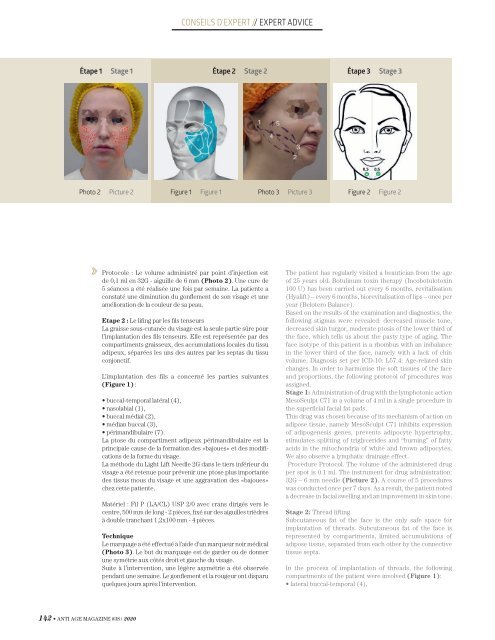ANTI-AGE #38
Create successful ePaper yourself
Turn your PDF publications into a flip-book with our unique Google optimized e-Paper software.
CONSEILS D’EXPERT // EXPERT ADVICE<br />
Étape 1 Stage 1 Étape 2 Stage 2 Étape 3 Stage 3<br />
Photo 2 Picture 2 Figure 1 Figure 1 Photo 3 Picture 3 Figure 2 Figure 2<br />
Protocole : Le volume administré par point d’injection est<br />
de 0,1 ml en 32G - aiguille de 6 mm (Photo 2). Une cure de<br />
5 séances a été réalisée une fois par semaine. La patiente a<br />
constaté une diminution du gonflement de son visage et une<br />
amélioration de la couleur de sa peau.<br />
Etape 2 : Le lifing par les fils tenseurs<br />
La graisse sous-cutanée du visage est la seule partie sûre pour<br />
l’implantation des fils tenseurs. Elle est représentée par des<br />
compartiments graisseux, des accumulations locales du tissu<br />
adipeux, séparées les uns des autres par les septas du tissu<br />
conjonctif.<br />
L’implantation des fils a concerné les parties suivantes<br />
(Figure 1) :<br />
• buccal-temporal latéral (4),<br />
• nasolabial (1),<br />
• buccal médial (2),<br />
• médian buccal (3),<br />
• périmandibulaire (7).<br />
La ptose du compartiment adipeux périmandibulaire est la<br />
principale cause de la formation des «bajoues» et des modifications<br />
de la forme du visage.<br />
La méthode du Light Lift Needle 2G dans le tiers inférieur du<br />
visage a été retenue pour prévenir une ptose plus importante<br />
des tissus mous du visage et une aggravation des «bajoues»<br />
chez cette patiente.<br />
Matériel : Fil P (LA/CL) USP 2/0 avec crans dirigés vers le<br />
centre, 500 mm de long - 2 pièces, fixé sur des aiguilles trièdres<br />
à double tranchant 1,2x100 mm - 4 pièces.<br />
Technique<br />
Le marquage a été effectué à l’aide d’un marqueur noir médical<br />
(Photo 3). Le but du marquage est de garder ou de donner<br />
une symétrie aux côtés droit et gauche du visage.<br />
Suite à l’intervention, une légère asymétrie a été observée<br />
pendant une semaine. Le gonflement et la rougeur ont disparu<br />
quelques jours après l’intervention.<br />
The patient has regularly visited a beautician from the age<br />
of 25 years old. Botulinum toxin therapy (Incobotulotoxin<br />
100 U) has been carried out every 6 months, revitalisation<br />
(Hyalift) – every 6 months, biorevitalisation of lips – once per<br />
year (Belotero Balance).<br />
Based on the results of the examination and diagnostics, the<br />
following stigmas were revealed: decreased muscle tone,<br />
decreased skin turgor, moderate ptosis of the lower third of<br />
the face, which tells us about the pasty type of aging. The<br />
face isotype of this patient is a rhombus with an imbalance<br />
in the lower third of the face, namely with a lack of chin<br />
volume. Diagnosis set per ICD-10: L57.4: Age-related skin<br />
changes. In order to harmonise the soft tissues of the face<br />
and proportions, the following protocol of procedures was<br />
assigned.<br />
Stage 1: Administration of drug with the lymphotonic action<br />
MesoSculpt C71 in a volume of 4 ml in a single procedure in<br />
the superficial facial fat pads.<br />
This drug was chosen because of its mechanism of action on<br />
adipose tissue, namely MesoSculpt C71 inhibits expression<br />
of adipogenesis genes, prevents adipocyte hypertrophy,<br />
stimulates splitting of triglycerides and “burning” of fatty<br />
acids in the mitochondria of white and brown adipocytes.<br />
We also observe a lymphatic drainage effect.<br />
Procedure Protocol. The volume of the administered drug<br />
per spot is 0.1 ml. The instrument for drug administration:<br />
32G – 6 mm needle (Picture 2). A course of 5 procedures<br />
was conducted once per 7 days. As a result, the patient noted<br />
a decrease in facial swelling and an improvement in skin tone.<br />
Stage 2: Thread lifting.<br />
Subcutaneous fat of the face is the only safe space for<br />
implantation of threads. Subcutaneous fat of the face is<br />
represented by compartments, limited accumulations of<br />
adipose tissue, separated from each other by the connective<br />
tissue septa.<br />
In the process of implantation of threads, the following<br />
compartments of the patient were involved (Figure 1):<br />
• lateral buccal-temporal (4),<br />
142 • <strong>ANTI</strong> <strong>AGE</strong> MAGAZINE <strong>#38</strong> | 2020

















